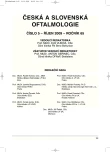Changes of Higher Order Aberrations and Contrast Sensitivity after Standard Photorefractive Keratectomy
Authors:
V. Loukotová; E. Vlková; M. Horáčková; E. Tokošová; L. Pirnerová; Z. Hlinomazová; D. Dvořáková; J. Němec
Authors‘ workplace:
Oční klinika LF MU, FN Brno, přednosta prof. MUDr. E. Vlková, CSc.
Published in:
Čes. a slov. Oftal., 65, 2009, No. 5, p. 176-181
Overview
The aim of the prospective study was to evaluate higher order aberrations and contrast sensitivity after photorefractive keratectomy (PRK) using the standard photoablation profile.
Materials and methods:
The group consisted of 37 patients (69 eyes), the mean age 27.2 ± 4.5 years, who underwent PRK with target emetropia during the period January 2007 –December 2007. In 19 cases, it was correction of myopia, in 50 cases myopia with astigmatism. The preoperative spherical equivalent was -3.14 ± 0.95 D. The PRK was performed by means of excimer laser system Technolas 217 (Bausch & Lomb) with the standard phoptoablation profile (PlanoScanTM 2000), using the 6.5 mm optical zone. The visual acuity, contrast sensitivity (CS; CSV-1000E, VectorVision) under mesopic circumstances and monochromatic aberrations (Zywave, Bausch & Lomb) were evaluated before the surgery, and 1, 3, 6, and 12 months thereafter. The pair t-test, Wilcoxon test, and the Mann – Whitney U test (α = 0.05) were used for the statistical analysis.
Results:
The PRK showed high index of effectiveness and safety (0.98, respectively 1.03 in the first year after the procedure). The contrast sensitivity under mesopic circumstances was not significantly involved after the PRK. The main value of the CS remained during the whole follow-up period within the physiological range in all spatial frequencies. Postoperatively, the part of spherical aberration on the higher order aberrations increased from 13.1 % preoperatively to 16.6 % one year after the PRK. In one half of the cases, the change of the higher order aberrations was within the range ± 0.1 μm. In 66 % of cases, the change of the spherical aberration was ± 0.05 μm. The higher order aberrations comparing to the preoperative values decreased or remained unchanged approximately in one third of the cases, and the spherical aberration in one quarter of the cases. There was not established dependence between monochromatic aberrations values and the contrast sensitivity.
Conclusion:
Although the conventional RPK for low myopia treatment induces higher order aberrations including the spherical aberration, the impact on the contrast sensitivity under mesopic circumstances in our group were not significant. The contrast sensitivity of the most of patients was near the upper limit of the normal range.
Key words:
photorefractive keratectomy, higher order aberrations, wavefront analysis, contrast sensitivity
Sources
1. Appletate, R.A., Gansel, K.A.: The importance of pupil size in optical quality measurmements following radial keratotomy, Refract Corneal Surg, 1990, 6: 47–54
2. Burakgazi, A. Z., Tinio, B., Bababyan, A., et. al. : Higher Order Aberrrations in Normal Eyes Measured With Three Different Aberometers, J Refract Surg, 2006, 22: 898–903
3. Butuner, Z., Elliott, D. B., Gimgel, H. V. at al.: Visual function one year after laser photorefractive keratectomy, J Refract Corenael Surg, 1994, 10: 625–630
4. Ghaitt, A. A., Daniel, J., Stulting, R. D. at al.: Contrast sensitivity and glare disability after radial keratotomy and photorefractive keratectomy, Arch. Ophthalmol, 1998, 116: 12–18
5. Hiatt, J. A., Grant, C. N., Wachler, B.S.B.: Establishing Analysis Paremeters for Spherical Aberration after Wavefront LASIK, Am. J. Ophthalmol., 112, 2005, 112: 998–1002
6. Lawless, M. A., Hodge., Ch.: Wavefrontęs role in corneal refractive surgery, Clinical and Experimental Ophthalmology, 2005, 33: 199-209
7. Lhmann, C. P., Fitzke, F. W., OęBart, D. P. S. at al.: Halos – a problem for all myopes? A comparison between spectacles, contact lenses and photorefractive keratectomy. Refract Corneal Surg, 1993, 9: S72-S75
8. Martínez, C. E., Applegate, R. A., Klyce, S. D. at al.: Effect of pupil dilation on corneal optical aberrations after photorefractive keratectom, Arch Ophthalmol, 1998, 116: 1053–1062
9. Mrochen, M., Kaemmerer, M., Mierdel, P. at al.: Increased higher-order optical aberrations after laser refractive surgery, J Cataract Refract Surg, 2001, 27: 362–369
10. Netto, M. V., Ambrosio, R., Wilson, S. E.: Pupil size in refractive surgery candidates, J Cataract Refract Surg, 2004, 20: 337–342
11. Oliver, K. M., Hemenger, R. P., Corbett, M. C., at al.: Corneal optical aberrations induced by photorefractive keratectomy, J Refract Surg, 1997, 13: 246–254
12. Oshika, T., Klyce, S. D., Applegate, R. A. at al.: Comparison of corneal wavefront aberrations after photorefractive keratectomy and laser in situ keratomileusis, Am J Ophthalmol, 1999, 127: 1–7
13. Pepose, J. S., Applegate, R. A.: Making sense out of waferont sensing, Am J Ophthalmol, 139, 2005, 2: 335–343
14. Feuermannová, A., Komenda, I., Rozsíval, P.: Wavefront analýza – nový směr ve vyšetřování a léčbě refrakčních vad. In Rozsíval, P., Trendy soudobé oftalmologie – svazek 4, Praha, Galén, 2007, s. 37–60
15. Seiler, T., Reckmann, W., Maloney, R. K.: Effective spherical aberration of the cornea as a quantitative descriptor in corneal topography, J Cataract Refract Surg, 1993, 19: 155–165
16. Tanabe T., Miyata, K., Samejima, T. at al.: Influence of wavefront aberration and corneal subpepithelial haze on low-contrast visual acuity after photorefractive keratectomy, Am J Ophthalmol, 2004, 138: 620–624
17. Vetrugno, M., Quaranta, G. M., Maino, A., at al.: Contrast sensitivity measured by 2 methods after photorefractive keratectomy, J Cataract Refract Surg, 2000, 26: 847–852
18. Wang, Z., Chen, J., Yang, B.: Comparison of laser in situ keratomileusis and photorephractive keratectomy to correct myopia from -1.25 to -6.0 diopters, J Refract Surg, 1997, 13: 528–534
Labels
OphthalmologyArticle was published in
Czech and Slovak Ophthalmology

2009 Issue 5
Most read in this issue
- Diagnosing of Acanthamoeba Keratitis
- Current Therapeutic Approach in Non-infectious Uveitis
- Benefit of the Surgical Treatment of the Idiopathic Intracranial Hypertension – a Case Report
- Contrast Sensitivity and Higher Order Aberration after Conventional LASIK Treatment
